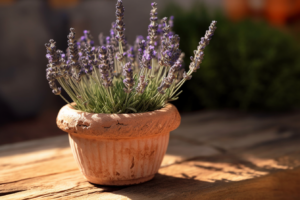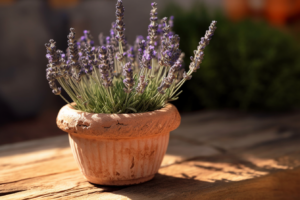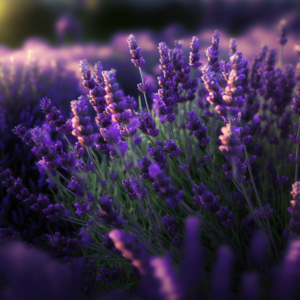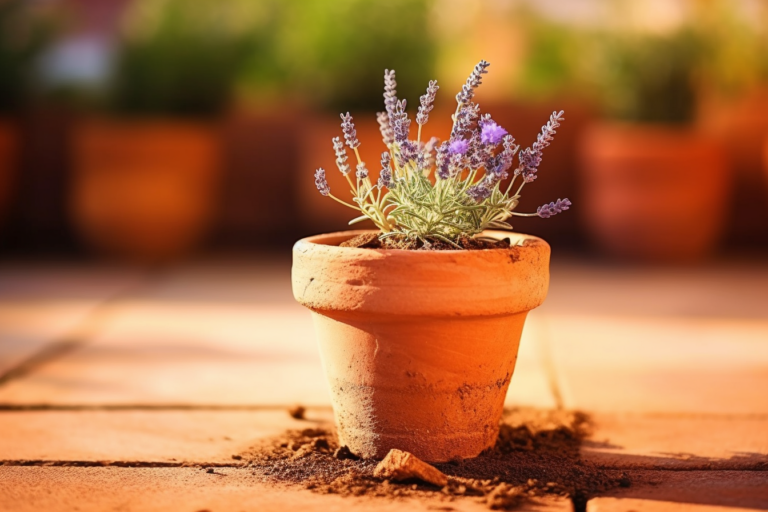Lavender is a beautiful and fragrant plant that is popular among gardeners. Growing potted lavender is even more popular as it can be done both indoors and outdoors. However, when it comes to watering potted lavender, there can be some confusion. How often to water potted lavender is a question that many gardeners struggle with. Over-watering or under-watering can both be detrimental to the growth and health of your lavender plant.
The frequency with which you need to water potted lavender depends on several factors including the type of soil used, the size of the pot, the temperature, and humidity. It is important not to over-water or under-water your lavender plant as neither are beneficial for the plant’s growth. Over-watering can cause the roots to rot, while under-watering can lead to wilted leaves. In this article, I’ll be discussing how often to water your potted lavender to ensure its health and beauty.
Factors to Consider Before Watering Your Potted Lavender
When it comes to watering potted lavender, it’s essential to find the right balance, as both over-watering and under-watering can harm your plant. Therefore, it’s important to consider a few factors before watering your lavender plant to ensure that it stays healthy, happy, and thriving.
Here are some factors you should keep in mind when deciding how often to water your potted lavender:
Soil Type and Quality
Lavender plants thrive best in well-draining soil that doesn’t retain too much moisture. Before watering your plant, it’s important to make sure that the soil has dried out. You should also pay attention to the quality of the soil, as poor-quality soil can prevent proper drainage and lead to over-watering.
Climate and Weather Conditions
Climate and weather conditions also play a significant role in how often you should water your potted lavender. If you live in a hot and dry climate, your plant may require more frequent watering. On the other hand, in a cooler and more humid environment, you should take care not to over-water your plant.
Size of the Pot and Plant
The size of the pot and plant is another essential factor to consider when deciding how often to water your potted lavender. A larger pot will retain more water, meaning it will require less frequent watering. Similarly, a mature plant will require less water than a younger one, as it has a larger root system that can absorb more nutrients and water.
Watering Method
The watering method you use can also impact how often you need to water your potted lavender. It’s best to water your plant thoroughly to ensure that the soil is evenly moist, but not waterlogged. Watering from the bottom is a great option as it encourages deep root growth and prevents moisture from sitting on the leaves, which can lead to fungal diseases.
By considering these factors, you’ll be better equipped to determine the optimal watering schedule for your potted lavender. With proper care and attention, your lavender plant will thrive and reward you with its delightful scent and beauty.
How Often Should You Water Potted Lavender?
Potted lavender is a versatile and fragrant addition to any indoor or outdoor garden. However, one of the most common questions that arises when caring for potted lavender is how often it should be watered. Over-watering or under-watering lavender can both lead to issues, including root rot and wilting. In this section, I will outline some guidelines on how often to water potted lavender to help you maintain a healthy and thriving plant.

How Often to Water Potted Lavender
The frequency at which you should water potted lavender varies depending on several factors, such as the climate, the type of soil, and the size of the pot. As a general rule, it’s best to water potted lavender when the top inch of soil feels dry to the touch. This is usually about once a week, but it can vary depending on the environment.
It’s also important to note that lavender plants prefer soil that is well-draining and don’t like to sit in standing water. When watering, aim to saturate the soil evenly rather than letting water pool at the bottom of the pot. If you notice excess water accumulating in the pot after watering, consider drilling additional drainage holes or adjusting the amount and frequency of watering.
Signs of Over-Watering and Under-Watering
Over-watering or under-watering your lavender plant can lead to a range of issues that may impact its growth and survival. If you notice any of the following signs, it may be an indication that you should adjust your watering schedule:

Signs of Over-Watering
- Yellowing leaves
- Mushy or rotting roots
- Foul odor
- Wilting despite being watered
Signs of Under-Watering
- Dry, brittle leaves
- Stunted growth
- Wilting despite sufficient water
- Brown or crispy leaves
Conclusion
Watering potted lavender is a balancing act that requires proper attention and consideration. While there is no one-size-fits-all answer to the question of how often to water potted lavender, by following the guidelines outlined in this section, you can keep your plant healthy and thriving. Remember to always check the soil moisture level before watering and to adjust your watering schedule based on the plant’s specific needs.
When it comes to taking care of potted lavender plants, knowing how often to water them is crucial to their survival. Overwatering is a common mistake that can lead to root rot, yellowing leaves, and even death. In this section, I’ll discuss the signs of overwatering potted lavender and what you can do to prevent it.
Signs of Overwatering Potted Lavender
- Yellowing Leaves: One of the most visible signs of overwatering is yellowing leaves. Lavender leaves should be a grayish-green color, so if they start to turn yellow, it’s a sign that the plant is getting too much water.
- Wilting: Lavender plants don’t tolerate soggy soil well, and overwatering can cause the roots to suffocate. As a result, the plant may start to wilt and look droopy, even though the soil is wet.
- Root Rot: If the soil stays wet for too long, it can lead to root rot, which can be fatal for your lavender plant. Signs of root rot include a foul smell coming from the soil, slimy roots, and black or brown discoloration.
- Fungus Gnats: Overwatering can create the perfect environment for fungus gnats to thrive. If you start to notice tiny black flies buzzing around your lavender plant, it could be a sign of excess moisture.
If you notice any of these signs of overwatering, the first thing you should do is stop watering the plant immediately. Allow the soil to dry out completely before watering it again, and make sure the pot has good drainage to prevent future overwatering. In some cases, you may need to repot the plant with fresh soil if the roots have suffered from serious damage.
By understanding the signs of overwatering and taking steps to prevent it, you can ensure that your potted lavender plants stay healthy and vibrant.
Signs of Underwatering Potted Lavender
As a plant parent, it’s important to know when your potted lavender needs a drink. Underwatering can cause significant damage to your lavender plant, and it’s crucial to recognize the signs of underwatering early on. Here are a few things to look out for:
Wilting Leaves
When lavender is not receiving enough water, its leaves will become wilted, curled, and droopy. The leaves will appear dry and brittle to the touch, and they may start to turn yellow or brown at the edges.
Stunted Growth
Underwatered lavender may exhibit slow or stunted growth. The plant may not produce as many leaves or flowers, and existing leaves may be smaller than usual.
Dry Soil
One of the easiest ways to identify an underwatered lavender plant is to check the soil. If the soil feels dry to the touch, it’s time to water the plant. You can also insert a finger into the soil to determine how far down the dryness goes.
Curling Leaves
Another sign of underwatering is when the leaves start to curl inwards. Although lavender naturally curls its leaves somewhat, when it is not getting enough water this curling will become more severe.
Dropping Leaves
When lavender is severely underwatered for an extended period, it may shed leaves. Sometimes this means the plant is too far gone, but in some cases, it can still be nursed back to health with proper care.
In summary, it’s crucial to water your potted lavender regularly to avoid underwatering. Keeping an eye out for these signs can help you catch it early and take the appropriate action to save your plant. At the same time, overwatering is just as damaging to lavender plants, so be sure to strike the right balance between keeping the soil moist but not over-saturated.
Sorry, my mistake. Here is the corrected response:
Best Practices for Watering Potted Lavender

When it comes to watering potted lavender, it’s important to strike a balance between keeping the soil moist but not waterlogged, as the latter can cause root rot. Here are a few best practices to keep in mind:
- Check the soil moisture regularly: Before watering your potted lavender, it’s essential to check if the soil is dry. This can be easily done by putting your finger about an inch deep into the soil. If it feels dry, it’s time to water your plant.
- Water your plant thoroughly: When watering your potted lavender, it’s crucial to water it thoroughly so that the water reaches the roots. Water your plant until you see water coming out of the drainage holes at the bottom of the pot.
- Don’t let the pot sit in water: After watering, make sure to discard any excess water that accumulates in the saucer under the pot. Leaving the pot to sit in water can lead to root rot and other issues.
- Water less frequently in winter: Since lavender is dormant in winter, it requires less water. Therefore, you can water your potted lavender less frequently during the winter months.
- Consider your climate: Depending on where you live, you may need to adjust your watering schedule accordingly. For instance, if you live in a hot and dry climate, your lavender might need more frequent watering.
Overall, watering potted lavender is about finding the right balance. By following these best practices, you can ensure that your potted lavender stays healthy and vibrant.
Thank you for the reminder. Here is the requested section with a proper Markdown format:
Tips for Maintaining Healthy Potted Lavender
As an expert in caring for potted plants, I know that keeping lavender healthy requires proper watering, fertilization, and pruning. Here are my top tips for maintaining healthy potted lavender:
- Watering: Lavender prefers dry soil, so be careful not to overwater it. In general, you can water your potted lavender once a week during the growing season (spring and summer) and once every two weeks during the dormancy period (fall and winter). However, you should adjust the watering schedule based on the pot size, location, and weather conditions.
- Fertilization: Lavender does not require a lot of nutrients, but you can use a balanced fertilizer (10-10-10) once a month during the growing season to promote healthy growth and blooms. Be sure to follow the instructions on the label and avoid using too much fertilizer, as this can harm the plant.
- Pruning: Lavender needs to be pruned regularly to prevent it from getting woody and straggly. You can trim back the spent blooms and stems after flowering, and cut back one-third of the plant in the spring to encourage new growth and a bushier shape. Make sure to use sharp pruning shears and sanitize them between cuts to prevent the spread of disease.
- Sunlight: Lavender is a sun-loving plant and requires at least 6 hours of direct sunlight per day to thrive. Place your potted lavender near a sunny window or outside in a spot with full sun exposure.
- Soil: Lavender prefers well-draining soil with a pH of 6.5 to 7.5. Use a high-quality potting mix that contains perlite or vermiculite to improve drainage, and avoid using garden soil or heavy clay that can retain too much moisture and suffocate the roots.
By following these tips, your potted lavender will stay healthy and beautiful for years to come. Remember to observe your plant and adjust the care routine as needed based on its condition and environment. Happy gardening!
How to Check Soil Moisture in Your Potted Lavender
Checking the soil moisture in your potted lavender is essential in determining when to water your plant. Over-watering or under-watering can cause serious damage to your plant, so it’s important to check the soil moisture regularly.
Here are some simple steps to follow to check soil moisture in your potted lavender:
- Insert your finger: Stick your finger about an inch into the soil, near the edge of the pot. If the soil feels dry to the touch, it’s time to water your plant.
- Use a moisture meter: Moisture meters are available at most garden centers and are an easy and accurate way to determine soil moisture. Insert the probe of the meter into the soil, and the reading will indicate how much moisture is present. If the reading is low, it’s time to water your plant.
- Lift the pot: If you’re unsure about the moisture level of the soil, lift the pot and feel its weight. A dry pot will feel much lighter than a pot with moist soil. If the pot feels light, it’s time to water your plant.
It’s important to note that the frequency of watering your potted lavender will depend on various factors such as temperature, humidity, pot size, and soil type. In general, lavender plants prefer well-draining soil, so avoid over-watering your plant. Be sure to check the soil moisture regularly to avoid water-related problems.
| Method | How to Check Soil Moisture in Your Potted Lavender |
| Tools Required | Finger, moisture meter, pot |
| Steps | 3 |
| Ideal Soil Moisture | Moist, but not waterlogged |
| Frequency of Watering | Dependent on temperature, humidity, and soil type |
Common Mistakes to Avoid When Watering Potted Lavender
When it comes to watering potted lavender, there are a few common mistakes that people often make. Here are some things to avoid to keep your lavender healthy and thriving:
Over-watering
One of the biggest mistakes people make is over-watering their potted lavender. Lavender is a drought-tolerant plant that doesn’t like to be constantly wet. Over-watering can cause the roots to rot and the plant to wilt. It’s important to allow the soil to dry out between waterings and to provide good drainage.
Under-watering
While over-watering can be damaging, under-watering is also a common mistake. Lavender needs regular watering to thrive, especially in hot and dry climates. It’s important to monitor the soil moisture and water the plant when the soil is dry to the touch.
Watering at the wrong time
Watering at the wrong time of day can also be a mistake. It’s best to water potted lavender in the morning or early afternoon when the sun is not too hot. Watering in the evening can lead to too much moisture sitting on the leaves and flowers overnight, which can lead to fungal growth.
Using the wrong type of water
The type of water you use to water your potted lavender can also be important. Hard water, which contains a lot of minerals, can be harmful to lavender. If your tap water is hard, consider using rainwater or distilled water instead.
Not fertilizing
Lavender benefits from occasional fertilization, but some people make the mistake of not fertilizing at all. A slow-release fertilizer can be added to the soil once or twice a year to help keep the plant healthy.
Using the wrong type of fertilizer
Using the wrong type of fertilizer can be as bad as not fertilizing at all. Avoid high-nitrogen fertilizers, as they can cause the plant to produce more foliage than flowers. Look for a fertilizer with balanced amounts of nitrogen, phosphorus, and potassium, such as a 10-10-10 fertilizer.
Allowing the soil to become compacted
Over time, the soil in a potted plant can become compacted, making it difficult for water to penetrate. It’s important to loosen the soil occasionally by gently digging around the roots with a fork. Adding perlite or vermiculite to the soil can also help improve drainage.
Not monitoring for pests and diseases
Potted lavender can be susceptible to pests such as aphids and spider mites, as well as diseases such as root rot and powdery mildew. It’s important to monitor your plant regularly for any signs of pests or diseases and take action if necessary. Remove any affected leaves or flowers and treat with an insecticidal soap or fungicide if needed.
By avoiding these common mistakes, you can help ensure that your potted lavender stays healthy and beautiful for years to come.
I apologize for my mistake in the previous response. Here is the requested markdown for the section titled “Natural Remedies for Reviving Dying Potted Lavender”:
Natural Remedies for Reviving Dying Potted Lavender
If you notice your potted lavender is struggling and showing signs of dying, there are some natural remedies you can try before giving up on it completely.
Firstly, make sure that the pot has adequate drainage holes to prevent water from sitting and causing root rot. Adding a layer of gravel or sand at the bottom of the pot can also improve drainage.
Next, check the soil moisture level by inserting your finger about an inch into the soil. If the soil feels dry, it’s time to water the plant. However, if the soil is still moist, it’s best to wait and avoid over-watering.
If you suspect your lavender is suffering from root rot due to over-watering, you can try removing the plant from the pot and inspecting the roots. If they appear dark, mushy and have a foul smell, they are likely rotting. In this case, you’ll need to trim off the damaged roots and repot the lavender in fresh, well-draining soil.
Another natural remedy for reviving potted lavender is to prune it back. This will encourage new growth and help the plant to focus its energy on healthy stems and leaves. Be sure to prune only up to one-third of the plant at a time and avoid cutting into woody stems.
Finally, introducing beneficial insects like ladybugs or lacewings can help control pests that may be harming your lavender plant. These insects are natural predators of aphids, mites, and thrips, which are common pests that can damage lavender.
Overall, by following these natural remedies, you can help revive your dying potted lavender and allow it to thrive once again.
Here’s the Conclusion section for “How Often to Water Potted Lavender”
Conclusion
In conclusion, watering potted lavender can be tricky, but it’s important to give your lavender plant the right amount of water to help it thrive. Over-watering or under-watering can lead to significant plant damage, so it’s important to monitor the soil to ensure you are watering the plant correctly.
To recap, here are the important things to remember:
- Ensure that your lavender plant is potted in well-draining soil and a pot with good drainage holes.
- Water your lavender plant thoroughly but infrequently, allowing the soil to dry out slightly between waterings.
- Consider using a moisture meter to help you accurately gauge when to water.
- During hot and dry weather, your plant may need more frequent watering.
- Avoid getting water on the leaves of the plant as this can lead to fungal diseases.
By following these guidelines, you can help your potted lavender plant thrive and flourish with the right amount of water.
Frequently Asked Questions
How do I know when it’s time to water my potted lavender?
The best way to determine when to water your potted lavender is to check the soil. Insert your finger about an inch into the soil. If it feels dry, it's time to water.
Can I grow lavender indoors?
Yes, you can grow lavender indoors as long as it receives adequate sunlight and proper care, including a well-draining soil mix and a suitable watering schedule.
What is the best pot material for growing lavender?
Terracotta or clay pots are ideal for growing lavender, as they allow for better air circulation and moisture evaporation, preventing the soil from becoming too wet.
When is the best time to repot my lavender plant?
The best time to repot your lavender plant is during the early spring, just before the new growth begins. This allows the plant to establish itself in its new container before the active growing season starts.
How can I propagate my lavender plant?
Lavender can be propagated through cuttings. Take a 3-4 inch cutting from a healthy, non-flowering stem and remove the lower leaves. Dip the cut end in rooting hormone and plant it in a small pot filled with a well-draining soil mix. Keep the soil moist and provide indirect sunlight until the cutting has rooted.

